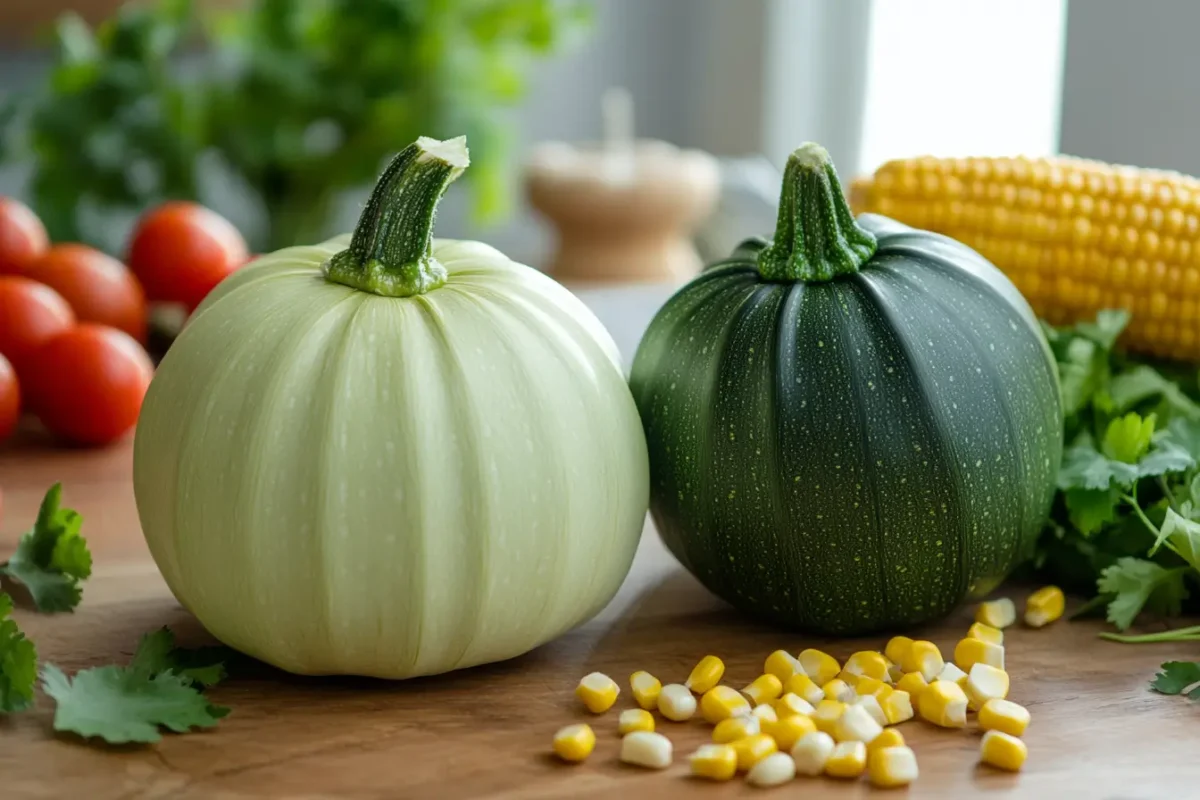Zucchini and calabacita are often mentioned together in recipes and gardening discussions, but are they truly the same? These two squashes, while similar in many ways, have distinct characteristics that make them unique. This article dives into their botanical backgrounds, culinary uses, nutritional profiles, and even myths surrounding them. By the end, you’ll not only have the answer to is calabacita the same as zucchini? but also a deeper appreciation for these versatile vegetables. Let’s begin!
Introduction to Calabacita and Zucchini
Why Compare Calabacita and Zucchini?
At first glance, calabacita and zucchini might seem the same. Both are green, oval-shaped squashes that are common in summer dishes. But their origins, tastes, and textures tell a unique story. Zucchini is often linked to Italian and Mediterranean cooking, while calabacita has strong ties to Mexican and Latin American cuisine.
Understanding their differences not only helps cooks choose the right ingredient but also sheds light on how cultural and botanical histories shape what we eat.
What This Article Will Cover
This article will address common questions, such as:
- What sets calabacita apart from zucchini?
- Can they be used interchangeably in recipes?
- What are their unique culinary roles?
We’ll also explore their nutritional benefits, growth patterns, and some popular recipes that highlight their individual flavors. Whether you’re a seasoned gardener or a curious foodie, this guide will provide all the details you need to confidently answer, is calabacita the same as zucchini?
Botanical Background and Classification
The Botanical Relationship Between Calabacita and Zucchini
Calabacita and zucchini are part of the same squash family and have a lot in common, but small differences often raise the question, is calabacita the same as zucchini? Zucchini is a type of Cucurbita pepo, while calabacita refers to a wider variety of summer squashes found in Mexico and Latin America. This includes some types of Cucurbita pepo and Cucurbita moschata.
The key distinction lies in their appearance and history. Zucchini, a European squash, has a sleeker, uniform shape and is typically dark green. Calabacita, on the other hand, comes in various shades and shapes, often smaller and rounder, with light green or striped skin.
Key Differences in Varieties and Growing Conditions
Calabacita grows well in warm climates and is a key part of traditional farming methods like the “Three Sisters,” planted with corn and beans. Zucchini, which comes from Italy, prefers soil that drains well and cooler weather. Both plants grow edible flowers, but calabacita flowers are usually larger and more commonly used in Mexican dishes.
For those interested in gardening, this guide offers tips on cultivating both vegetables, highlighting their growth habits and pest resistance.
Culinary Differences and Preferences
How is Calabacita Used in Mexican and Latin Cuisine?
Calabacita is an important part of Latin American cooking. Its mild, sweet flavor goes well with foods like corn, tomatoes, and cheese. Dishes like calabacitas con elote (squash with corn) and calabacitas guisadas (stewed squash) show how flexible it is. The flowers, called flor de calabaza, are also loved for their light taste and are often added to quesadillas and soups.
Zucchini’s Role in International Dishes
Zucchini is popular worldwide and used in dishes like Italian ratatouille and zucchini bread in the U.S. Its firm texture is great for grilling and stuffing, making it a favorite for many meals. Zucchini’s mild taste also works well with bold spices, making it ideal for curries and casseroles.
Do Calabacita and Zucchini Taste the Same?
Calabacita and zucchini have similar flavors, but they’re not the same. Calabacita is sweeter and softer, while zucchini is firmer with a mild, earthy taste. These differences affect how they’re best used in cooking. For example, calabacita is great for stews and sautés, while zucchini works well in baked or grilled dishes.
To explore unique ways to cook both vegetables, visit this recipe collection, which offers creative ideas to celebrate their flavors.
Nutritional Profiles Compared
Nutritional Value of Calabacita
Calabacita is a healthy vegetable packed with important vitamins and minerals. It’s high in vitamin C, potassium, and antioxidants like beta-carotene, which help keep the heart strong and boost the immune system. With its low calories and carbs, it’s a great option for managing weight and following low-carb diets.
One key benefit of calabacita is its fiber, which supports digestion and keeps blood sugar levels steady. If you’re wondering, is calabacita the same as zucchini nutritionally?, you’ll find they are similar. However, calabacita has a bit more natural sugar, giving it a sweeter taste.
Zucchini’s Health Benefits
Zucchini, like calabacita, is low in calories and full of nutrients. It has a high water content and is rich in vitamin A, which supports eye health, and manganese, which helps keep bones strong. Zucchini also has lutein and zeaxanthin, antioxidants that protect the body from damage.
Although both squashes are similar in nutrition, zucchini’s firm texture makes it great for grilling and other dishes. This shared health value shows why both are great choices for a balanced diet.
For inspiration on incorporating these veggies into your meals, explore this collection of vegetable-based recipes.
Popular Myths and Misconceptions
Is Calabacita Just a Smaller Zucchini?
Many people think calabacita is just a smaller zucchini, but that’s not true. While they are both part of the squash family, they are not the same. Calabacita includes different types of summer squash, some of which are rounder and lighter in color than zucchini. It also has a sweeter taste and softer texture that make it unique.
This mix-up often happens because the terms are used differently in various places. By learning their differences, you can easily answer the question, is calabacita the same as zucchini?
Can You Use Them Interchangeably?
Some people think calabacita and zucchini can always be used the same way in recipes, but that’s not true. Calabacita’s sweet flavor might change the taste of savory dishes if it’s not balanced with other ingredients. Zucchini, with its firmer texture, works better for dishes like stuffed squash or grilled slices.
For recipes tailored to each squash’s unique qualities, consider checking out this guide to calabacitas recipes. It provides helpful tips and flavorful ideas for both varieties.
Growing and Harvesting Insights
Calabacita vs. Zucchini: Gardening Tips
Growing calabacita and zucchini well means knowing what they need. Both grow best in warm weather with lots of sunlight, but their growth habits are slightly different. Zucchini plants are bushy and compact, making them great for smaller gardens. Calabacita, however, often spreads out more, so it needs extra space.
For healthy plants, use soil that drains well and is rich in nutrients. Water them regularly, but don’t get the leaves wet to avoid fungus. Adding mulch can help keep the soil moist and cut down on weeds, which is helpful for both types of squash.
Challenges and Pests Unique to Each Plant
Like other garden plants, calabacita and zucchini can have problems. Squash bugs, powdery mildew, and vine borers are common pests for both. Zucchini’s thick leaves can make it harder to see pests, while calabacita’s spreading vines may need more checks for diseases.
Picking at the right time is important for good flavor and texture. Harvest calabacita when it’s small and tender, and pick zucchini when it’s 6–8 inches long. If left too long, both can get tough and lose their taste, so it’s best to harvest on time.
For more gardening insights, consider exploring a dedicated guide to growing summer squash.
Recipes Highlighting Calabacita and Zucchini
Traditional Calabacita Recipes

Calabacita shines in classic Mexican dishes, where its sweet flavor complements bold ingredients like chiles, cheese, and corn. One beloved recipe is calabacitas con elote, a hearty sauté of squash, corn, and tomatoes seasoned with garlic and spices. Another favorite is sopa de flor de calabaza (squash blossom soup), which showcases the edible flowers of the plant.
These recipes not only highlight calabacita’s culinary versatility but also its cultural significance in traditional Latin cuisine. For a complete guide to making these dishes, see this collection of calabacita recipes.
Creative Recipes Using Zucchini

Zucchini’s mild flavor and firm texture make it popular in today’s kitchens. You can use it for zucchini noodles (zoodles), stuffed zucchini, and many other dishes. It’s also great in baked goods like zucchini bread, adding moisture and a touch of flavor to sweet treats.
Grilled zucchini slices with olive oil and herbs are a quick and tasty option. For something different, try using zucchini with bold spices in curries or stir-fries.
Try this zucchini bread recipe.
How to Combine Both in Fusion Dishes
If you’re wondering, is calabacita the same as zucchini?, why not try both? Using them together in one dish creates a tasty mix of textures and flavors. A mix of zucchini’s firm texture and calabacita’s sweetness can make stir-fries, casseroles, and soups even better.
These recipes show that both vegetables are great for your kitchen, whether you use them alone or together.
FAQs About Calabacita and Zucchini
Why Are They Often Confused?
The similarities between calabacita and zucchini can confuse even skilled cooks and gardeners. Both are green summer squashes with mild flavors, so they often seem the same in recipes. But small differences, like calabacita’s sweeter taste and zucchini’s firmer texture, make them unique.
When someone asks, is calabacita the same as zucchini?, the answer lies in these nuances. Calabacita is often smaller and lighter in color, while zucchini is darker and more uniform in shape. Understanding these distinctions can help you choose the right squash for your needs.
How to Tell Calabacita Apart From Zucchini in Stores
Identifying calabacita at the market is simple once you know what to look for. Calabacita is usually rounder or shorter with pale green or striped skin. Zucchini, on the other hand, is typically longer, with smooth, dark green skin. Labels may not always specify the type, so visual cues are key.
Best Ways to Cook Each Vegetable
Calabacita’s soft texture makes it perfect for stews, sautés, and soups. It soaks up flavors well, especially when mixed with strong spices. Zucchini works better in dishes that need a firmer texture, like grilling, stuffing, or making noodles. Choosing the right way to cook them brings out the best in each squash.
What Is the History Behind These Vegetables?
Zucchini comes from Italy, while calabacita has its roots in the Americas, where it was grown by indigenous people as part of the “Three Sisters” farming method. Their unique histories add to their importance in cooking and culture, making them much more than just similar vegetables.
Conclusion and Final Thoughts
The Verdict: Are Calabacita and Zucchini the Same?
To sum up, is calabacita the same as zucchini? No, they are not exactly the same, but they are closely related. Both belong to the squash family and can be used in similar ways when cooking. However, their unique traits make each one special. Whether you’re making a traditional Mexican dish with calabacita or trying zucchini in a new recipe, knowing their differences helps you enjoy the best of both.
Why These Vegetables Deserve More Attention
Calabacita and zucchini are healthy, versatile, and simple to cook, making them must-haves in any kitchen. Their unique textures and flavors can enhance many dishes, from hearty stews to fresh summer salads. By appreciating what makes each special, you can enjoy more variety in your cooking and celebrate the wide range of foods from around the world.
For more recipes featuring these wonderful squashes, explore this ultimate guide to calabacitas recipes. Whether you’re a seasoned chef or a home cook, these vegetables are sure to inspire your next meal!

